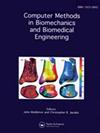Accuracy of machine learning techniques for real-time prediction of implanted lower limb mechanics with comprehensive and reduced input parameters.
IF 1.6
4区 医学
Q3 COMPUTER SCIENCE, INTERDISCIPLINARY APPLICATIONS
Computer Methods in Biomechanics and Biomedical Engineering
Pub Date : 2025-09-23
DOI:10.1080/10255842.2025.2554259
引用次数: 0
Abstract
This study evaluates the accuracy of machine learning techniques for real-time prediction of implanted knee mechanics. A musculoskeletal lower limb model was used to generate joint mechanics for a training dataset of 1500 simulations with varying surgical alignments, loading, and ligament properties. The objective was to determine the minimum input dataset required to estimate implanted biomechanics using three predictive methods: linear-regression, bi-directional long short-term memory (biLSTM), and transformer-based models. Results indicate that the biLSTM model had ∼45% lower nRMSE than the other models with reduced inputs. In the longer-term, this may aid in optimizing implant positioning pre- or intra-operatively.
机器学习技术在全面和减少输入参数的植入下肢力学实时预测中的准确性。
本研究评估了机器学习技术用于实时预测植入膝关节力学的准确性。使用肌肉骨骼下肢模型为1500个模拟训练数据集生成关节力学,这些模拟具有不同的手术对齐、负载和韧带特性。目的是确定使用三种预测方法估计植入生物力学所需的最小输入数据集:线性回归、双向长短期记忆(biLSTM)和基于变压器的模型。结果表明,与输入减少的其他模型相比,biLSTM模型的nRMSE低约45%。从长期来看,这可能有助于优化术前或术中植入物的定位。
本文章由计算机程序翻译,如有差异,请以英文原文为准。
求助全文
约1分钟内获得全文
求助全文
来源期刊
CiteScore
4.10
自引率
6.20%
发文量
179
审稿时长
4-8 weeks
期刊介绍:
The primary aims of Computer Methods in Biomechanics and Biomedical Engineering are to provide a means of communicating the advances being made in the areas of biomechanics and biomedical engineering and to stimulate interest in the continually emerging computer based technologies which are being applied in these multidisciplinary subjects. Computer Methods in Biomechanics and Biomedical Engineering will also provide a focus for the importance of integrating the disciplines of engineering with medical technology and clinical expertise. Such integration will have a major impact on health care in the future.

 求助内容:
求助内容: 应助结果提醒方式:
应助结果提醒方式:


